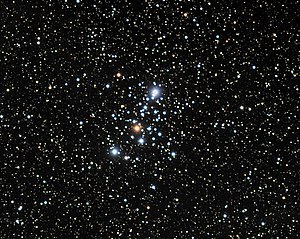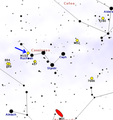Messier 103
| Messier 103 | |
|---|---|
 Open cluster Messier 103 in Cassiopeia | |
| Observation data (J2000.0 epoch) | |
| Right ascension | 01h 33.2m |
| Declination | +60° 42′ |
| Distance | 10 thousand light-years (3 kpc[1]) |
| Apparent magnitude (V) | 7.4 |
| Apparent dimensions (V) | 6.0' |
| Physical characteristics | |
| Other designations | NGC 581, Cr 5 |
Messier 103 (also known as M103, or NGC 581) is an open cluster where a few hundred, mainly very faint, stars figure in Cassiopeia.[a] It was discovered in 1781 by Charles Messier's friend and collaborator Pierre Méchain.[2] It is one of the more distant open clusters, 8,000 to 9,500 light-years from the Solar System[1][2] and ranging over about 15 light years. It holds about 40 certain-member stars,[2] two of which have magnitudes 10.5, and a 10.8 red giant, which is the brightest within the cluster. A bright known foreground object is the star Struve 131,[3] not a member of the cluster. The cluster may have 172 stars if including those down to 50% probability of a gravitational tie.[3] M103 is about 25 million years old.[2]
Observation history[]
After the discovery of Messier 101 through 103, Messier had no cause to carry out more detailed observations of these clusters and included them as an addition to his catalogue using the data of Méchain.[3][4] In 1783, William Herschel observed M103 and described the region as 14 to 16 pL (pretty large stars) and with great many eS or extremely faint ones.[5] Åke Wallenquist then identified 40 stars in M103 while Antonín Bečvář raised the number to 60. Archinal and Hynes then determined that the cluster had 172 stars.[3] Admiral William Henry Smyth was the first to see the 10.8-magnitude red giant, citing the double star on Cassiopeia's knee, about a degree to the northeast of Delta Cassiopaiae (Ruchbah/Rukhbah).
Observing with binoculars[]
Messier 103 has been rated by the Astronomical League[3] as an easy[6] object to find and the cluster is visible even with the use of binoculars.[3][7] M103 can be seen as a nebulous fan-shaped patch, and takes up about a 6 arcminute′ circle (a tenth of a degree), about a fifth the apparent diameter of the moon. To find M103, it is suggested that the observer center their binoculars on Ruchbah or the bottom left (or right against a northern horizon, as it more often is from Earth) star of the signature “W” asterism of Cassiopeia. The cluster will appear as a hazy patch about 1⁄3 of a field/line toward 45 Epsilon Cassiopeia, a northern endpoint of the W, on the outer side of the W.
Gallery[]

M103 image from Aladin Sky Atlas

Finder chart for M103
References and footnotes[]
- ^ a b Sanner, J.; Geffert, M.; Brunzendorf, J.; Schmoll, J. (1999). "Photometric and kinematic studies of open star clusters. I. NGC 581 (M 103)". Astronomy and Astrophysics. 349: 448–456. arXiv:astro-ph/9908059. Bibcode:1999A&A...349..448S.
- ^ a b c d Robert Bruce Thompson [1], M103 (open cluster in Cassiopeia). Accessed online 13 April 2011
- ^ a b c d e f "Messier 103: Observations and Descriptions". SEDS. Retrieved 13 April 2011.
- ^ "3 Clusters in Cassiopeia". One Minute Astronomer. Archived from the original on 22 February 2011. Retrieved 14 April 2010.
- ^ "Messier 103". Universe Today. 7 January 2010. Retrieved 14 April 2010.
- ^ "Messier 103". Perez Media. Retrieved 14 April 2010.
- ^ "The Constellation Cassiopeia". Zimbio. Archived from the original on 11 October 2012. Retrieved 14 April 2010.
- ^ It remains below the northern horizon below the 30th parallel south, and viewing is not ideal until for fifteen degrees of rising above that horizon, that is from the 15th parallel south, northwards
External links[]
| Wikimedia Commons has media related to Messier 103. |
- Open Cluster M103 @ SEDS Messier pages
- Open Cluster M103 @ Skyhound.com
- NASA Astronomy Picture of the Day: Distant Open Cluster M103 (7 February 2001)
- Messier 103 on WikiSky: DSS2, SDSS, GALEX, IRAS, Hydrogen α, X-Ray, Astrophoto, Sky Map, Articles and images
Coordinates: ![]() 01h 33.2m 00s, +60° 42′ 00″
01h 33.2m 00s, +60° 42′ 00″
- Open clusters
- Cassiopeia (constellation)
- Messier objects
- NGC objects
- Astronomical objects discovered in 1781
- Perseus Arm
- Discoveries by Pierre Méchain


